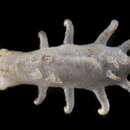zh-TW
在導航的名稱


Elpidia glacialis is a species of sea cucumber in the family Elpidiidae. It is found at abyssal depths in the Arctic Ocean, the Barents Sea, the Kara Sea and the north Atlantic Ocean. It was first described in 1876 by the Swedish zoologist Johan Hjalmar Théel after he had collected specimens while accompanying the explorer Adolf Erik Nordenskiöld on an expedition attempting to find the Northeast Passage.[2]
In a study in the Greenland Sea, E. glacialis occurred on the lower slopes of the continental shelf at depths of about 2,700 metres (8,900 ft). Other organisms occupying the same habitat included the sea lily Bathycrinus sp., the sea spider Ascorhynchus abyssi, the brachiopod Waldheimia cranium and the zoanthid Epizoanthus sp. The sea lily and the sea cucumber were the dominant species present, perhaps because echinoderms are able to adopt various foraging strategies to suit the availability of food supplies.[3]
In another study, in the central Arctic Ocean, it was found that most of the megafauna was only found within a certain range of depths, the only exceptions to this being E. glacialis and the predatory swimming snail Limacina helicina. The depth of the seabed in the study area of the Canada Basin was about 3,800 metres (12,500 ft).[4] A further study, this time in a canyon in the western part of the Greenland Sea at a depth of about 3,200 metres (10,500 ft), found E. glacialis was sometimes present with an abundance of up to sixty individuals per 1 square metre (11 sq ft). It is a deposit feeder and its abundance may reflect differences in the availability of food in the sediment.[5]
Elpidia glacialis is a species of sea cucumber in the family Elpidiidae. It is found at abyssal depths in the Arctic Ocean, the Barents Sea, the Kara Sea and the north Atlantic Ocean. It was first described in 1876 by the Swedish zoologist Johan Hjalmar Théel after he had collected specimens while accompanying the explorer Adolf Erik Nordenskiöld on an expedition attempting to find the Northeast Passage.
Elpidia glacialis est une espèce de concombre de mer de la famille Elpidiidae. On le retrouve dans les profondeurs de l'océan Arctique, dans la mer de Barents, de Kara ainsi que dans l'océan Atlantique Nord. L'espèce été décrite pour la première fois en 1876 par le zoologiste Johan Hjalmar Théel (en), après que ce dernier ait collecté quelques spécimens alors qu'il accompagnait l'explorateur Adolf Erik Nordenskiöld lors d'une expédition ayant pour objectif de trouver le passage du Nord-Est[2].
Une étude du bassin du Canada publiée en 1978 montre que la plus grande partie de la mégafaune se retrouve seulement à certaines palettes de profondeurs, avec pour seules exceptions E. glacialis et Limacina helicina. Le plancher océanique de la zone étudiée était situé à environ 3 800 m de profondeur[3].
Dans une autre étude publiée en 1996 et concernant la mer du Groenland, Michela Mayer et Dieter Piepenburg ont remarqué que E. glacialis se retrouve sur les pentes profondes du plateau continental, à environ 2 700 m de profondeur, parmi d'autres taxons tels le Bourgueticrinida (en) Bathycrinus sp., l'araignée de mer Ascorhynchus abyssi, Waldheimia cranium et Epizoanthus sp.. Le Bourgueticrinida et le concombre de mer y étaient les espèces dominantes[4].
En 2003, une autre étude se concentrant sur une fosse d'environ 3 200 mètres de profondeur de la partie ouest de la mer du Groenland, observe que E. glacialis est parfois présent avec une densité de population atteignant 60 individus par mètre carré[5].
Elpidia glacialis est une espèce de concombre de mer de la famille Elpidiidae. On le retrouve dans les profondeurs de l'océan Arctique, dans la mer de Barents, de Kara ainsi que dans l'océan Atlantique Nord. L'espèce été décrite pour la première fois en 1876 par le zoologiste Johan Hjalmar Théel (en), après que ce dernier ait collecté quelques spécimens alors qu'il accompagnait l'explorateur Adolf Erik Nordenskiöld lors d'une expédition ayant pour objectif de trouver le passage du Nord-Est.
Elpidia glacialis is een zeekomkommer uit de familie Elpidiidae.
De wetenschappelijke naam van de soort werd in 1876 gepubliceerd door Johan Hjalmar Théel.
Bronnen, noten en/of referentiesElpidia glacialis là một loài hải sâm trong họ Elpidiidae. Nó được tìm thấy ở độ sâu thẳm ở Bắc Băng Dương, Biển Barents, biển Kara và phía bắc Đại Tây Dương. Loài này được mô tả lần đầu tiên vào năm 1876 bởi nhà động vật học người Thụy Điển Johan Hjalmar Théel sau khi ông đã thu thập các mẫu vật trong khi đi cùng các nhà thám hiểm Adolf Erik Nordenskiold trên một chuyến thám hiểm cố gắng để tìm kiếm hành lang Đông Bắc.
Trong một nghiên cứu ở biển Greenland, E. glacialis hiện diện trên sườn dưới của thềm lục địa ở độ sâu khoảng 2.700 m (8.900 ft). Sinh vật khác chiếm môi trường sống cùng loài này bao gồm huệ biển Bathycrinus sp., nhện biêtn Ascorhynchus abyssi, brachiopod Waldheimia và zoanthid Epizoanthus sp. Các loài huệ biển và hải sâm là loài chiếm ưu thế hiện nay, có lẽ bởi vì động vật da gai có thể áp dụng chiến lược tìm kiếm thức ăn khác nhau để phù hợp với sự sẵn có của các nguồn cung cấp thức ăn.
Elpidia glacialis là một loài hải sâm trong họ Elpidiidae. Nó được tìm thấy ở độ sâu thẳm ở Bắc Băng Dương, Biển Barents, biển Kara và phía bắc Đại Tây Dương. Loài này được mô tả lần đầu tiên vào năm 1876 bởi nhà động vật học người Thụy Điển Johan Hjalmar Théel sau khi ông đã thu thập các mẫu vật trong khi đi cùng các nhà thám hiểm Adolf Erik Nordenskiold trên một chuyến thám hiểm cố gắng để tìm kiếm hành lang Đông Bắc.